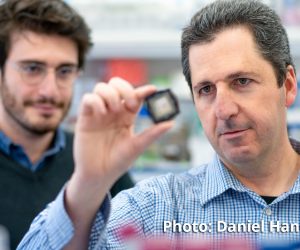
How to Become “Indistractable”: Learn How to Harness Technology and Other Distractions to Improve Mental and Brain Health
Dr. Caroline Leaf – Let’s face it: distractions are a part of life; whether you are interrupted by your children or a news flash or social media. But what happens when distractions take over your life, affecting your ability to function and complete even the most basic of tasks? What happens when you just can’t stop getting distracted?
As I discuss in this week’s blog and podcast with Nir Eyal, bestselling author and speaker, research shows the ability to stay focused is a competitive advantage, in work and in life. However, in an age of ever-increasing demands on our attention, the ability to concentrate is constantly under threat. How do we get the best from technology without letting it get the best of us?
In Nir’s latest book, Indistractable, he notes how technology is designed to “hack” our attention, like any other consumer product. However, we need to stop using the way technology is designed as an excuse. Yes, some people are genuinely addicted to technology, but not everyone who uses technology is an addict. Yet it is often more convenient for us to call our love of technology an addiction, which looks to a “dealer” or someone we can blame, rather than seeing it for what it really is: a distraction, which requires us to take a certain degree of personal responsibility for how we engage with modern technology and the world around us.
The best way to understand what a distraction is is to understand its opposite: traction. Traction means to pull you towards an action with intent, that is to go where you want to go in order to achieve something you would like to achieve. A distraction, on the other hand, is the opposite: it takes you away from where you want to go or what you want to achieve—it takes you away from your intent or target.
Of course, we need to be aware of how the overuse of technology can distract us and have negative mental side-effects, such as a lack of sleep and lack of face-to-face social connection, which are so necessary for our mental health. However, we also need to acknowledge that we can break bad thinking habits, even if we live in a world full of distractions. We need to learn how to use technology with intent, rather than allowing it to use us and take control of our lives. Humans have always been prone to distractions—2500 years ago the Greek philosopher Plato was complaining about our ability to get distracted, so we cannot just blame modern technology! We must learn how to get the best out of technology, rather than letting it get the best out of us.
This is especially the case if we care going through a difficult time or facing a challenging situation. The truth is, we are not designed to be happy all the time, as much as the self-help industry would like us to believe. Often, facing the source of our discomfort helps us move forward in life, which is why we need to use our negative feelings to find traction in our lives and improve our situation, rather than getting distracted by our desire to suppress our unease or pain. We need to listen to our internal triggers, rather than suppressing them by getting distracted by social media, checking the news, watching the latest Netflix drama and so on. We have to learn how to deal with the hard stuff in life, because it doesn’t just go away if we suppress it! If we aren’t aware of how we use distractions to ignore our discomfort, however, we can end up forming a negative habit, which is a lot harder to get rid of! The key is to stop our distractions before they become bad behaviors!
But how do we take steps to make sure we don’t go about our days distracted? Is it possible to use modern technology in a healthy way, without becoming fully dependent on it? How can we avoid using things as distractions, and start gaining traction in our lives?
1. Deal with the internal:
When it comes to getting distracted, we should not just disconnect and swear off all technology. Indeed, abstinence can often backfire: if I told you right now to not think about a white bear, what is the first image that comes to mind? If we foreswear all technology, we may end up with worse media habits than before—when we eventually give in the brain registers the release of tension as pleasure, which can reinforce bad habits! Indeed, for many people, technology is part and parcel of their everyday lives: they need it to communicate with friends, family and colleagues, and cannot just give it up.
Rather, when we feel discomfort we should use it as a learning experience to gain traction in life: we need to “master our internal triggers”, as Nir puts it. This is one of the main reasons why I designed my new app SWITCH, which is a tool for helping people deal with their issues and overcome distractive thought patterns and behaviors through the mental process of reconceptualization, that is facing and dealing with what is causing them pain and unease, before it takes over their lives.
2. Schedule it in:
Anything can be a distraction, just as anything can give your traction. This is why it is so important to ask ourselves why we do what we do, and how we are using something in our life. Social media, for example, can be used to connect us to our loved ones and engage in their lives, no matter how far away they are, or it can be used as a distraction to mask boredom or to procrastinate. The same can be said for watching TV: we can incorporate it into our schedule as a way of resting our mind and relaxing, or we can let it take over our schedule as a distraction. By doing this, we can turn a distraction into a traction by scheduling it in to our day with intent, rather than letting it determine our day haphazardly and prevent us from doing what we need to do.
Remember, the time you plan to “waste” is not wasted time! Indeed, if you don’t plan for things, then everything can become a distraction, so schedule it in, even if it is just spending time on Instagram.
For more on social media and mental health, see my podcast (episodes #6, #7 and #50).
3. Hack back:
Recognize that companies want to hack your attention, and learn how to “hack” back. For example, instead of allowing emails to steal all your attention, calculate how much time you spend on emails (depending on how many you get a day) and limit this. Recognize that the more emails you send the more emails you will receive, because you have opened numerous chains of communication, and all of these will demand your focus. To “hack” back your attention, ask yourself: “when does this email need a reply?” and label it. Can it wait or is it urgent? Then, schedule in time to respond to the urgent emails only (which are usually around 20% of the emails you receive daily), and, after you have done this, schedule time in your week when you can flush through the rest of your emails. In many cases, you will find that about 50% of these emails will not need a reply; either people will have figured out their own issues or something else will have come up that is more urgent. By giving people time to wait, you will end up not wasting so much of your own time!
4. Use pacts:
A pact means making a promise to ourselves or someone else to do what we say we are going to do. These pacts can take many forms, including an effort pact, which involves some kind of friction regarding doing what we say we are going to do (such as a specific set of consequences), a price pact, which involves some monetary disincentive concerning what we said we are going to do (or not going to do), or an identity pact, where we use some kind of personal identity marker to help keep us on track. An identity pact, for instance, can be something like calling yourself a vegetarian: it is an identity marker that proscribes and inhibits certain behaviors. This is a way systematizing what we say and do, rather than just relying on pure willpower or determination to do something (or to stop doing something).
These principals also apply to raising children. We should not make our children afraid of technology, especially since they will likely have to use modern technology for school or in a job. However, children can easily become distracted by technology, which can impact their growth and performance.
This is why we need to look at the bigger picture: what drives children to technology? What are they looking for online? First, they are often looking for competency: there is so much pressure on children to perform and live up to certain test standards offline, which may compel them to look towards technology to help them feel like they are worth something—that they are good at something. If they are good at a video game or gaming app, for instance, this can give them a sense of competency and aptitude that they don’t get in their offline life. Second, many children turn to technology to give them a sense of autonomy: children today have ten times as many regulations placed on them compared to the average adult, and twice as many rules and restrictions as an incarcerated felon! In many cases, children go online to escape these restrictions and hyper-schedules; all day long they have been told what to do and they just want some freedom. Lastly, many children today lack relatedness: they don’t feel understood or accepted for who they are, they don’t have time to just be a kid, and turn to modern technology to help them feel some degree of kinship, like they have a place in the world.
When it comes to helping our children deal with distractions, we need to look beyond what they are doing and ask them how they are doing: communication, compassion and understanding are key to helping them turn their technology distractions into traction, which will help them succeed at school, work and in life without forcing them to give up modern technology and live “off the grid”.
To read the original article click here.
For more articles from Dr. Leaf click here.






